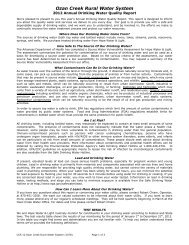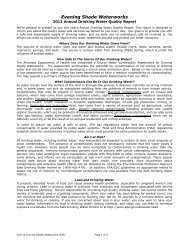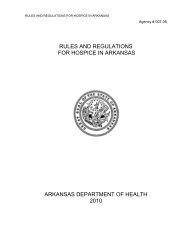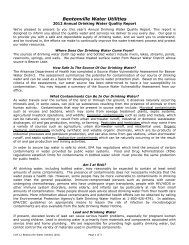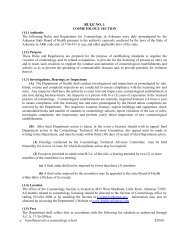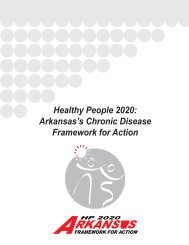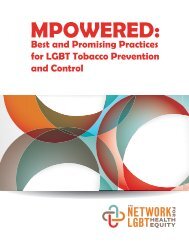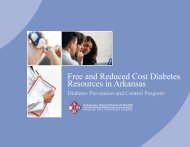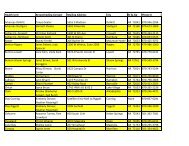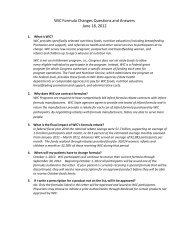Guidelines for Pool and Spa Operators - Arkansas Department of
Guidelines for Pool and Spa Operators - Arkansas Department of
Guidelines for Pool and Spa Operators - Arkansas Department of
You also want an ePaper? Increase the reach of your titles
YUMPU automatically turns print PDFs into web optimized ePapers that Google loves.
Shocking the <strong>Pool</strong><br />
Chloramine<br />
Dichloramine<br />
Some tips to remember when shocking:<br />
‣ Close the pool: over night or <strong>for</strong> 6-8 hrs (if using a non-chlorine shock product; swimmers can be admitted<br />
within 20 minutes. This product is primarily used in pools no larger than 40,000 gallon due to cost <strong>of</strong> product)<br />
‣ NEVER ADD CHEMICALS WHEN SWIMMERS ARE IN THE POOL<br />
‣ Shock when chloramines (Combined Chlorine - CC) exceed .2 ppm (total chlorine – free chlorine= if .2 or<br />
more then shock)<br />
‣ A mininum10-12 ppm <strong>of</strong> chlorine is needed to ‗burn-out‘ the chloramines, 20 ppm <strong>for</strong> liquid fecal release, <strong>and</strong><br />
<strong>for</strong> bad algae blooms/growth up to 30 ppm<br />
‣ H<strong>and</strong> feed mixture <strong>of</strong> chemical <strong>and</strong> water (when h<strong>and</strong> feeding granular chlorine is best to mix in bucket <strong>of</strong> water<br />
first to avoid burning the pool surface/liner <strong>and</strong> creating calcium deposits on pool surface <strong>and</strong> s<strong>and</strong> filters)<br />
*Note: DO NOT BROADCAST DRY PRODUCT - This is the only time a method <strong>of</strong> h<strong>and</strong> feeding is allowed<br />
‣ Always use proper eye <strong>and</strong> skin protection devices when adding chemicals<br />
‣ Lower pH to around 6.9 be<strong>for</strong>e adding chlorine<br />
‣ Measure the free chlorine levels the next morning be<strong>for</strong>e anyone gets into the pool<br />
‣ If the free chlorine reading is above 3 ppm use less chlorine the next time you superchlorinate<br />
‣ If the free chlorine reading is zero use more chlorine the next time you superchlorinate<br />
‣ High chlorine levels may bleach out the color <strong>of</strong> the DPD <strong>and</strong> give a false reading <strong>of</strong> zero chlorine; it is advised<br />
that you keep paper test strips on h<strong>and</strong> to check <strong>for</strong> excessive chlorine<br />
-------------------------------------------------------------------------------------------------------------------------------------------<br />
(Amount <strong>of</strong> chlorine compound to introduce 10ppm <strong>for</strong> every 5,000 gallons <strong>of</strong> water)<br />
Chlorine Product % chlorine 5,000 gal<br />
Calcium 65 .63 lbs<br />
hypochlorite** 78 .53 lbs<br />
**Recommended chemical <strong>of</strong> choice because it does not add stabilizer to water<br />
Take your pool volume <strong>and</strong> divide by 5,000 then multiply that answer by amount <strong>of</strong> chlorine product to get needed<br />
amount to shock the pool. For 20 ppm, double amount calculated, or <strong>for</strong> 30 ppm, just triple the amount calculated<br />
Example: 120,000 gallon pool using 65% cal hypo when combined chlorine level was above .2<br />
120,000 gal ÷ 5,000 gal = 24 24 x .63 lbs = 15.13 lbs <strong>of</strong> cal hypo need <strong>for</strong> shock<br />
9




